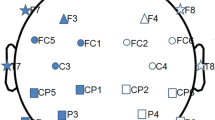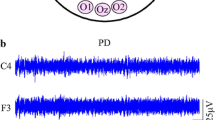Abstract
The aim of the present study was to analyze resting-state brain activity in patients with Parkinson’s disease (PD), a degenerative disorder of the nervous system. Magnetoencephalography (MEG) signals were recorded with a 151-channel whole-head radial gradiometer MEG system in 18 early-stage untreated PD patients and 20 age-matched control subjects. Artifact-free epochs of 4 s (1250 samples) were analyzed with Lempel–Ziv complexity (LZC), applying two- and three-symbol sequence conversion methods. The results showed that MEG signals from PD patients are less complex than control subjects’ recordings. We found significant group differences (p-values <0.01) for the 10 major cortical areas analyzed (e.g., bilateral frontal, central, temporal, parietal, and occipital regions). In addition, using receiver-operating characteristic curves with a leave-one-out cross-validation procedure, a classification accuracy of 81.58% was obtained. In order to investigate the best combination of LZC results for classification purposes, a forward stepwise linear discriminant analysis with leave-one out cross-validation was employed. LZC results (three-symbol sequence conversion) from right parietal and temporal brain regions were automatically selected by the model. With this procedure, an accuracy of 84.21% (77.78% sensitivity, 90.0% specificity) was achieved. Our findings demonstrate the usefulness of LZC to detect an abnormal type of dynamics associated with PD.





Similar content being viewed by others
References
Aboy, M., R. Hornero, D. Abásolo, and D. Álvarez. Interpretation of the Lempel–Ziv complexity measure in the context of biomedical signal analysis. IEEE Trans. Biomed. Eng. 53:2282–2288, 2006.
Anninos, P. A., A. V. Adamopoulos, A. Kotini, and N. Tsagas. Nonlinear analysis of brain activity in magnetic influenced Parkinson patients. Brain Topogr. 13:135–144, 2000.
Bosboom, J. L., D. Stoffers, C. J. Stam, B. W. van Dijk, J. Verbunt, H. W. Berendse, and E. Ch. Wolters. Resting state oscillatory brain dynamics in Parkinson’s disease: an MEG study. Clin. Neurophysiol. 117:2521–2531, 2006.
Bosboom, J. L., D. Stoffers, E. Ch. Wolters, C. J. Stam, and H. W. Berendse. MEG resting state functional connectivity in Parkinson’s disease related dementia. J. Neural Transm. 116:193–202, 2009.
Cassidy, M., and P. Brown. Task-related EEG–EEG coherence depends on dopaminergic activity in Parkinson’s disease. Neuroreport 26:703–707, 2001.
Eckmann, J. P., and D. Ruelle. Fundamental limitations for estimating dimensions and Lyapunov exponents in dynamical systems. Physica D 56:185–187, 1992.
Ferenets, R., T. Lipping, A. Anier, V. Jäntti, S. Melto, and S. Hovilehto. Comparison of entropy and complexity measures for the assessment of depth of sedation. IEEE Trans. Biomed. Eng. 53:1067–1077, 2006.
Fernández, A., R. Hornero, C. Gómez, A. Turrero, P. Gil-Gregorio, J. Matías-Santos, and T. Ortiz. Complexity analysis of spontaneous brain activity in Alzheimer disease and mild cognitive impairment: an MEG study. Alzheimer Dis. Assoc. Disord. 24:182–189, 2010.
Fernández, A., J. Quintero, R. Hornero, P. Zuluaga, M. Navas, C. Gómez, J. Escudero, N. García-Campos, J. Biederman, and T. Ortiz. Complexity analysis of spontaneous brain activity in attention-deficit/hyperactivity disorder: diagnostic implications. Biol. Psychiatry 65:571–577, 2009.
Gómez, C., R. Hornero, D. Abásolo, A. Fernández, and J. Escudero. Analysis of MEG background activity in Alzheimer’s disease using nonlinear methods and ANFIS. Ann. Biomed. Eng. 37:586–594, 2009.
Gómez, C., R. Hornero, D. Abásolo, A. Fernández, and M. López. Complexity analysis of the magnetoencephalogram background activity in Alzheimer’s disease patients. Med. Eng. Phys. 28:851–859, 2006.
Gusev, V. D., L. A. Nemytikova, and N. A. Chuzhanova. On the complexity measures of genetic sequences. Bioinformatics 15:994–999, 1999.
Hämäläinen, M., R. Hari, R. J. Ilmoniemi, J. Knuutila, and O. V. Lounasmaa. Magnetoencephalograpy—theory, instrumentation, and applications to noninvasive studies of the working human brain. Rev. Mod. Phys. 65:413–497, 1993.
Hornero, R., D. Abásolo, J. Escudero, and C. Gómez. Nonlinear analysis of electroencephalogram and magnetoencephalogram recordings in patients with Alzheimer’s disease. Philos. Trans. R. Soc. A 367:317–336, 2009.
Hughes, A. J., Y. Ben-Shlomo, S. E. Daniel, and A. J. Lees. What features improve the accuracy of clinical diagnosis in Parkinson’s disease: a clinicopathologic study. Neurology 42:1142–1146, 1992.
Hughes, A. J., Y. Ben-Shlomo, S. E. Daniel, and A. J. Lees. Improved accuracy of clinical diagnosis of Lewy body Parkinson’s disease. Neurology 57:1497–1499, 2001.
Jankovic, J. Parkinson’s disease: clinical features and diagnosis. J. Neurol. Neurosurg. Psychiatry 79:368–376, 2008.
Jeong, J., J. H. Chae, S. Y. Kim, and S. H. Han. Nonlinear dynamic analysis of the EEG in patients with Alzheimer’s disease and vascular dementia. J. Clin. Neurophysiol. 18:58–67, 2001.
Kaspar, F., and H. G. Schuster. Easily calculable measure for the complexity of spatiotemporal patterns. Phys. Rev. A 36:842–848, 1987.
Kotini, A., P. Anninos, A. Adamopoulos, and P. Prassopoulos. Low-frequency MEG activity and MRI evaluation in Parkinson’s disease. Brain Topogr. 18:59–63, 2005.
Kyriazis, M. Practical applications of chaos theory to the modulation of human ageing: nature prefers chaos to regularity. Biogerontology 4:75–90, 2003.
Lempel, A., and J. Ziv. On the complexity of finite sequences. IEEE Trans. Inf. Theory 22:75–81, 1976.
Méndez, M. A., P. Zuluaga, R. Hornero, C. Gómez, J. Escudero, A. Rodríguez-Palancas, T. Ortiz, and A. Fernández. Complexity analysis of spontaneous brain activity: effects of depression and antidepressant treatment. J. Psychopharm. 2011. doi:10.1177/0269881111408966.
Moore, D. J., A. B. West, V. L. Dawson, and T. M. Dawson. Molecular pathophysiology of Parkinson’s disease. Annu. Rev. Neurosci. 28:57–87, 2005.
Müller, V., W. Lutzenberger, F. Pulvermüller, B. Mohr, and N. Birbaumer. Investigation of brain dynamics in Parkinson’s disease by methods derived from nonlinear dynamics. Exp. Brain Res. 137:103–110, 2001.
Nutt, J. G., and G. F. Wooten. Diagnosis and initial management of Parkinson’s disease. N. Engl. J. Med. 353:1021–1027, 2005.
Pezard, L., R. Jech, and E. Růzicka. Investigation of non-linear properties of multichannel EEG in the early stages of Parkinson’s disease. Clin. Neurophysiol. 112:38–45, 2001.
Rapp, P. E., A. M. Albano, I. D. Zimmerman, and M. A. Jiminez-Montano. Phase-randomized surrogates can produce spurious identifications of nonrandom structure. Phys. Lett. A 192:27–33, 1994.
Serizawa, K., S. Kamei, A. Morita, M. Hara, T. Mizutani, H. Yoshihashi, M. Yamaguchi, J. Takeshita, and K. Hirayanagi. Comparison of quantitative EEGs between Parkinson disease and age-adjusted normal controls. J. Clin. Neurophysiol. 25:361–366, 2008.
Silberstein, P., A. Pogosyan, A. A. Kühn, G. Hotton, S. Tisch, A. Kupsch, P. Dowsey-Limousin, M. I. Hariz, and P. Brown. Cortico-cortical coupling in Parkinson’s disease and its modulation by therapy. Brain 128:1277–1291, 2005.
Simon, R., M. D. Radmacher, K. Dobbin, and L. M. McShane. Pitfalls in the use of DNA microarray data for diagnostic and prognostic classification. J. Natl Cancer Inst. 95:14–18, 2003.
Stam, C. J. Use of magnetoencephalography (MEG) to study functional brain networks in neurodegenerative disorders. J. Neurol. Sci. 289:128–134, 2010.
Stam, C. J., B. Jelles, H. A. Achtereekte, S. A. Rombouts, J. P. Slaets, and R. W. Keunen. Investigation of EEG non-linearity in dementia and Parkinson’s disease. Electroencephalogr. Clin. Neurophysiol. 95:309–317, 1995.
Stam, K. J., D. L. Tavy, B. Jelles, H. A. Achtereekte, J. P. Slaets, and R. W. Keunen. Non-linear dynamical analysis of multichannel EEG: clinical applications in dementia and Parkinson’s disease. Brain Topogr. 7:141–150, 1994.
Stoffers, D., J. L. Bosboom, J. B. Deijen, E. C. Wolters, H. W. Berendse, and C. J. Stam. Slowing of oscillatory brain activity is a stable characteristic of Parkinson’s disease without dementia. Brain 130:1847–1860, 2007.
Stoffers, D., J. L. Bosboom, J. B. Deijen, E. C. Wolters, C. J. Stam, and H. W. Berendse. Increased cortico-cortical functional connectivity in early-stage Parkinson’s disease: an MEG study. Neuroimage 41:212–222, 2008.
Yan, R., and R. X. Gao. Complexity as a measure for machine health evaluation. IEEE Trans. Instrum. Meas. 53:1327–1334, 2004.
Zhang, X. S., R, J. Roy, and E. W. Jensen. EEG complexity as a measure of depth of anesthesia for patients. IEEE Trans. Biomed. Eng. 48:1424–1433, 2001.
Zozor, S., P. Ravier, and O. Buttelli. On Lempel–Ziv complexity for multidimensional data analysis. Physica A 345:285–302, 2005.
Acknowledgments
This research was supported in part by the Ministerio de Ciencia e Innovación (Spain) under projects TEC2008-02241 and TEC2011-22987, the Dutch Parkinson Foundation (Parkinson Patiënten Vereniging), and the Dutch Foundation for Brain Research (Nederlandse Hersenstichting, grant no. 11F03(2)05). The authors wish to thank Diederick Stoffers for collecting the dataset used in this study.
Author information
Authors and Affiliations
Corresponding author
Additional information
Associate Editor Leonidas D. Iasemidis oversaw the review of this article.
Rights and permissions
About this article
Cite this article
Gómez, C., Olde Dubbelink, K.T.E., Stam, C.J. et al. Complexity Analysis of Resting-State MEG Activity in Early-Stage Parkinson’s Disease Patients. Ann Biomed Eng 39, 2935–2944 (2011). https://doi.org/10.1007/s10439-011-0416-0
Received:
Accepted:
Published:
Issue Date:
DOI: https://doi.org/10.1007/s10439-011-0416-0




